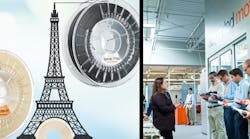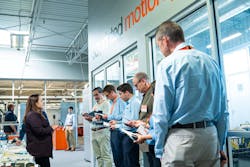Going Mainstream: Additive Manufacturing Bolsters Production Methods
At a Glance:
- Thanks to fast production, low costs and high design flexibility, additive manufacturing (a.k.a. 3D printing) is no longer in its infancy.
- A leading manufacturer of high-performance motion plastics, igus, has for years been selling 3D-printed components into printers. The company is extending the line of business with enhanced AM services.
- Best known for accelerating prototyping, AM allows manufacturers to explore new design features and create custom products at no extra cost.
Additive manufacturing is blossoming as a serious contender in the mature industrial business environment.
This much was clear when an entire pavilion was dedicated to AM at the IMTS 2022 show in Chicago (Sept. 12-17). Add to that the fact that AM technologies were prevalent across pavilions, from metal working and metal removal to components for NASA’s Artemis moon program and advances in hybrid technology (integrating additive and subtractive).
The global AM market is projected to grow from $18.33 billion in 2022 to $83.90 billion by 2029, according to Fortune Business Insights. The data correlate with how value chains are evolving with natural pressures brought on by advanced technologies, while reacting to a need to develop integrated manufacturing systems, say analysts.
That is not to say that there are no obstacles to overcome, noted Stephen LaMarca, a technology analyst with AMT (The Association for Manufacturing Technology) who participated in a virtual roundtable during National Manufacturing Week (Oct. 7-14). The economics for high volume AM products don’t always add up.
Also co-host of the AMT Tech Trends podcast, LaMarca counted three enduring roadblocks for manufacturers: materials, standards and integration.
“Materials availability and supply was really bolstered by standards coming forward and being developed for AM,” LaMarca said. “The biggest roadblock still is the integration—the acceptance of additive in the rest of the manufacturing industry.”
These limitations are steadily being overcome through commercially viable innovation in technologies, raw materials and end uses, he said.
Show, Don’t Tell
For a case in point, look no further than igus, a manufacturer of high-performance motion plastics, that is demonstrating how an established, global operation with a tradition of injection molding is expanding opportunities harnessed from AM technologies.
According to Nicole Lang, iglide product manager at igus, the company’s 3D printing business was initiated about six years ago, when colleagues at the igus factory and R&D facility in Cologne, Germany identified a need to help customers through their product development stages.
“Whether [a customer] only needed 500 pieces, or if they weren’t really set on the design, igus wanted to develop a faster way to get the parts to test, but still offer the advantage of an iglide material,” explained Lang. “We worked hard to develop 3D-printed materials, whether it be filament or SLS (selective laser sintering) powders for our laser sintering service, or now that we have a new DLP resin. It was important for us to develop materials that weren’t on the market as a standard ABS filament or traditional 3D-printing materials.”
RELATED: Hybrid Manufacturing Techniques Enable Production of a Bionic Hand
To meet these goals, igus developed highly wear-resistant 3D-printed materials made of high-performance polymers that share the same corrosion-resistant, dry-running (no lubrication needed) properties as the company’s signature iglide bearings, and were tested with the same rigor, said Lang.
At first igus offered materials for 3D printing for those entities with desktop printers and who had the facility to process FDM printed parts, but soon recognized there was an opportunity for clients that produce larger quantities, recalled Lang. The 3D printing business unit grew from being a process and service provider to a fully operational business. The East Providence, R.I. facility where Lang works is replete with SLS printers and an FDM printer.
Plans to grow the business in the U.S. are in the offing; Lang pointed to an online service that allows a user to upload a CAD model and order parts that come directly off the SLS print service. In addition, CAD configuration tools provide the technical benefit of having a user design a custom gear, for example. The ability to customize is especially helpful for applications where wear-resistance is needed and where clients need advice, Lang said.
Deposition Precision and Repeatability
AM can offer benefits where traditional manufacturing falls short. As a manufacturing method, AM has come a long way from being associated with prototyping and R&D; modeling software and best-in-class characteristics, deposition precision and repeatability have altered the way companies design and select materials, and it informs the way products can be distributed, sold and serviced.
Lang said igus has no shortage of examples by industry—from aerospace to automotive and the medical industry. The aerospace industry, in particular, has been a trailblazer in the use of 3D printing and benefits greatly from the versatility of 3D printing, she said. One of igus’ customers, who was accustomed to using an igus brand and materials for lightweighting, had been prototyping components for aircraft interior applications, but was not completely satisfied with their design.
“They had used igus iglide materials in the past, and are happy with them because of their lightweight characteristics,” said Lang. “We worked with them and went through many design changes. We 3D printed four different versions of a part for them throughout the product design stages, and we worked with them in the development of their product by printing the parts. We actually did some machining of parts as well. So, we have this full scope to help with all of these different changes that could potentially happen.”
Another customer needed special geometries for gears. However, the product did not warrant the investment in an injection-moulding tool, explained Lang, and igus could instead 3D print the gears with the required wear resistance every six to eight weeks as needed.
“They could order 55 gears with three different geometries, and it would be much more cost effective for them,” she said. “They didn’t want to invest in an injection mold and they needed the parts fairly quickly, because they don’t always know when they’re going to have demand or need for more. This was the perfect fit for them.”
Agile Production
If additive manufacturing is useful for designing the form, it has proven its place in testing functionality, too. An automotive customer needed a custom linkage but was unsure how long the linkage needed to be or where the wall studs needed to be positioned. “We were able to work with them through that process before we went to injection molding for much larger production quantities,” she said.
In Lang’s examples, the additional value generated through 3D printing methods outweigh concerns about higher production costs. Analysts like LaMarca would add that in engineering-intensive businesses, where the need to accelerate prototyping and explore new design features at low cost or no extra cost is essential, AM is pulling its weight as a competitive advantage. The same holds true for the ability to compete in short-run production of new parts and spare parts for legacy systems.
“In my opinion, the most disruptive thing about additive manufacturing is that it took a huge chunk—the most difficult, painful part of the workflow, going from design to physical part—maybe not out of the equation, but it is certainly reduced,” LaMarca said.



